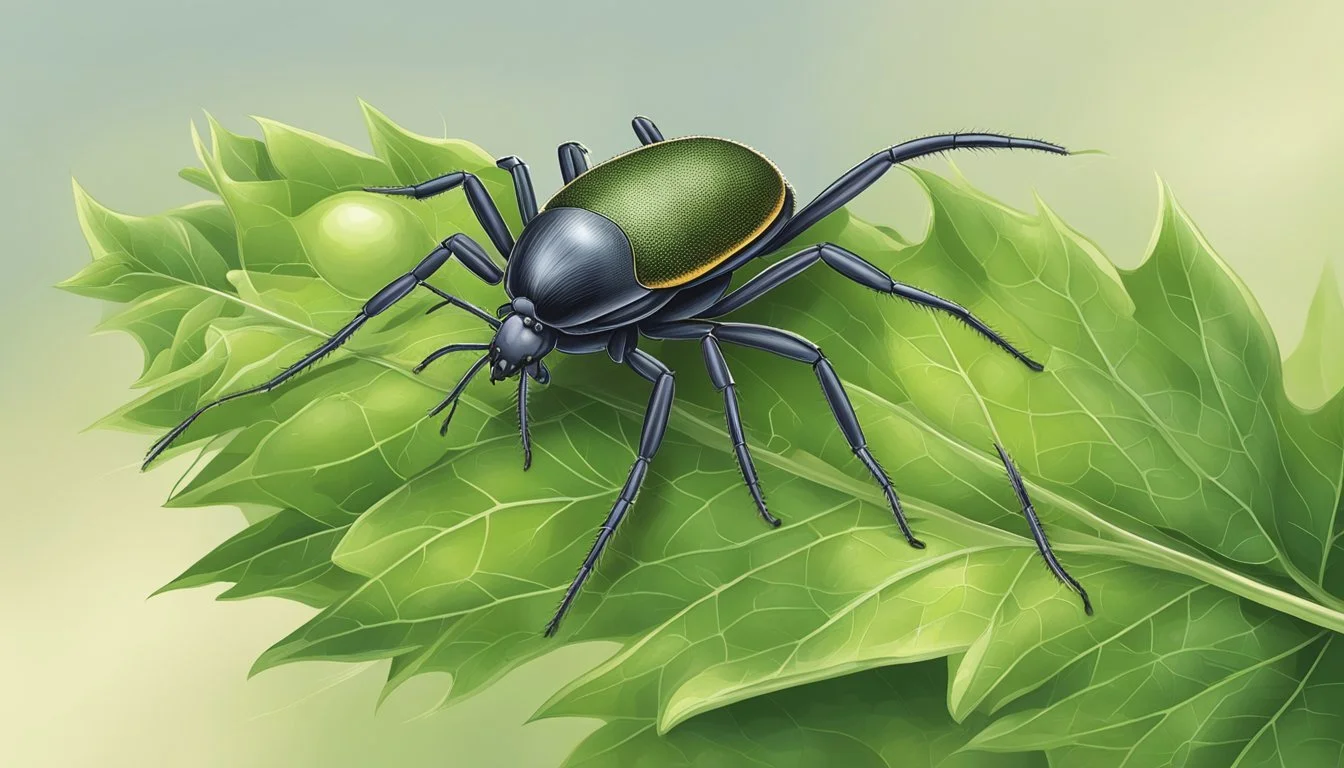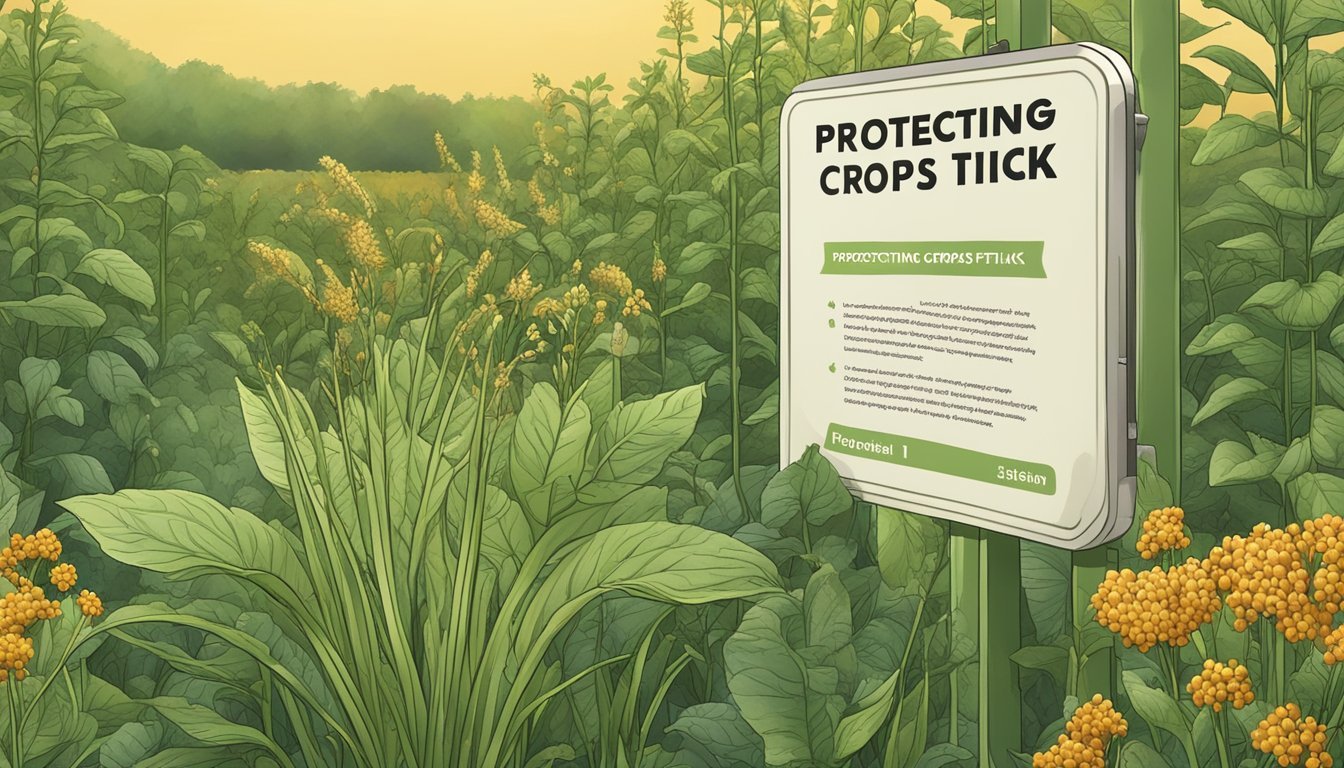Protecting Crops from Ticks
Effective Strategies for Pest Management
Ticks pose a significant threat to both livestock and crops, as these parasites can carry a range of diseases harmful to both animals and humans. For farmers, the risk of tick bites is not just a personal health concern, but also a critical factor in the health and productivity of their farms. It is essential to safeguard crops against these pests to prevent the spread of disease and to maintain the overall integrity of agricultural livelihoods.
In the agricultural setting, protecting crops from ticks involves integrated pest management strategies. These strategies may include landscape management practices that reduce tick-friendly environments, such as maintaining buffer zones between the wild and cultivated areas, and using natural tick repellants or pesticides that are safe for crops. It is also important to monitor livestock, as they can often be carriers for ticks into crop areas.
Awareness and proactive measures are key in managing the risk of tick infestation in agricultural domains. Farmers and agricultural workers must be equipped with knowledge about tick behavior, the lifecycles of ticks, and the potential hotspots for tick activity. By understanding where ticks are most likely to be found and how they interact with the environment, one can more effectively implement measures to protect crops and reduce the occurrence of tick bites, ultimately minimizing the risk to both personal health and the health of their crops.
Understanding Tick Biology and Behavior
Ticks are persistent ectoparasites with complex life cycles and behaviors that have significant implications for crop protection. Their ability to transmit pathogens to animal and plant hosts makes understanding their biology and behavior crucial for effective management strategies.
Lifecycle and Active Stages
The lifecycle of ticks includes four stages: egg, larva, nymph, and adult. Notably, Ixodes scapularis, commonly known as the blacklegged tick or deer tick, undergoes these stages, requiring a blood meal to progress to the next life stage. Larvae typically feed on small mammals like rodents, while nymphs and adults often choose larger hosts. Ticks are most active during warmer months, but activity can vary by species and geographic location.
Common Habitat and Hosts
Ticks favor moist and humid environments, which are typically found in wooded and grassy areas. Ixodes scapularis, in particular, thrives in such habitats, making these areas prime locations for the spread of tick-borne diseases. Host-seeking behavior sees larvae and nymphs clinging to low vegetation, whereas adults may climb higher but usually remain below waist level, as reported by the University of Maine Tick Lab. Identifying and modifying these habitats around agricultural areas can help reduce tick populations and the risk of disease transmission.
Identifying Tick Presence in Agricultural Areas
Effectively managing tick populations in agricultural settings is crucial to protect both crops and livestock. This involves diligent monitoring through visual checks and an understanding of environmental factors that can indicate tick presence.
Visual Inspection of Crops and Livestock
Crops: Regularly inspect the crops, paying special attention to those near brush or wooded areas, as ticks are more likely to be in proximity to these habitats. Signs to watch for include tiny specs moving on plants or clear evidence of distress in the crop that might indicate pest activity.
Livestock: Examine livestock thoroughly, looking for ticks in and around the ears, under the belly, and between the legs. Ticks attached to the animals may cause irritation, leading to symptoms such as a rash or fever, indicative of possible tick-borne diseases like Lyme disease.
Searching for Environmental Indicators
Grass and Leaf Litter: Ticks thrive in moist and shaded environments provided by grassland and leaf litter. Areas with high grass or dense leaf litter should be inspected with cloth dragging techniques that help estimate tick populations.
Deer and Wildlife Tracks: The presence of deer or wildlife tracks in or around agricultural zones can be a significant indication of tick populations, as these animals are common hosts for ticks seeking a blood meal.
Wooded and Outdoors: Inspect the edges of fields bordering wooded areas, particularly spots with piles of wood, which can be prime locations for ticks. Awareness of these environmental indicators and implementing management strategies can help reduce the risk of tick-borne diseases and protect the agricultural area.
Personal Protection Measures for Farmers and Workers
For farmers and workers facing the risk of tick bites in agricultural settings, adopting effective personal protection strategies is crucial. These measures revolve around choosing the right clothing and repellents, and cultivating a robust awareness of tick presence coupled with safety practices.
Appropriate Clothing and Repellents
Clothing: Wearing light-colored, long-sleeved shirts and long pants tucked into socks can create a physical barrier against ticks. This makes ticks more visible against the light fabric should they attempt to latch on. Farmers and workers are advised to opt for clothes treated with tick repellents for added defense.
Repellents for Skin and Clothing:
DEET: A repellent that can be applied directly to exposed skin. It's advisable to use a product with a concentration of 20-30% for several hours of protection.
Permethrin: This can be used to treat clothing and is effective in neutralizing ticks on contact. Do not apply permethrin directly on the skin.
Picaridin and IR3535: These are alternatives to DEET for skin application, known for their efficacy and less odor.
Awareness and Safety Practices
Examine Clothing and Hair: After outdoor work, it is critical for individuals to check their clothing and hair for ticks. Light-colored clothes make spotting ticks easier, and if any are found, they should be promptly removed.
Environmental Modifications: Reducing tick habitats, like tall grasses where ticks thrive, can diminish the likelihood of tick encounters. Maintaining paths and trails to avoid overgrown vegetation is recommended.
Personal Vigilance: Recognizing tick-prone areas and staying on the alert can significantly decrease the chances of tick bites. Regular tick checks are a must, especially after a day in the field. Ticks favor warm, moist areas of the body—checking under the arms, around the ears, inside the belly button, behind the knees, in and around the hair, between the legs, and around the waist is essential.
Using these precautions, farmers and workers can mitigate the risks posed by ticks and focus on their essential roles in the farming community without the added concern of tick-borne diseases.
Tick Control Strategies for Crop Protection
Effective tick control involves integrated strategies that combine chemical interventions with environmental management. These approaches aim to reduce tick populations in crop areas, thus protecting crops and minimizing exposure to tick-borne diseases.
Chemical Treatments and Pesticides
Insecticides play a crucial role in tick control within the agricultural sector. Farmers apply pesticides carefully and selectively to target tick-infested areas while minimizing impact on the crops. Products like acaricides are specifically designed to combat ticks. They can be administered through various methods, such as spray applications, which are effective in reaching the ticks on lower vegetation around crop perimeters. It is essential that chemical treatments are used according to the manufacturer's instructions and only when necessary to avoid resistance buildup and non-target effects on beneficial insects.
Application Areas:
Near fences
Along crop perimeters
Within landscaping features
Pesticides Usage:
Schedule regular treatments during peak tick activity.
Select chemicals approved for your specific crop and tick species.
Environmental Management Practices
Landscaping and maintenance practices significantly contribute to deterring ticks from crop areas. Clearing tall grasses, weeds, and unneeded vegetation reduces tick habitats. Farmers can create tick-free zones by ensuring that patios, fences, and other farm structures have well-maintained perimeters. By minimizing areas where ticks thrive, the likelihood of infestation in crop zones decreases.
Vegetation Management:
Trim grass and weeds regularly.
Remove leaf litter and trim shrubs.
Perimeter Practices:
Establish gravel or wood-chip barriers between lawns and wooded areas.
Maintain fences to prevent wildlife hosts from bringing in new ticks.
Animal Management and Tick Prevention
Effective animal management and tick prevention involve strategies that protect both domestic and wild animals from tick infestations and consequent tick-borne diseases. These measures are critical in reducing the risk to livestock, pets, and the surrounding wildlife populations.
Protecting Livestock and Pets
Livestock, such as cattle and horses, are often at risk for tick bites, which can lead to tick-borne diseases. To protect these valuable animals, farmers implement a variety of methods. Regular tick checks are essential, particularly focusing on areas where ticks are prone to attach, such as the ears, neck, udder, and tail. For smaller pets like dogs and cats, using tick prevention products like collars, topical treatments, or oral medications can significantly reduce the incidence of tick infestations.
Pasture Management: Maintaining the fields and pastures by mowing and removing tall grasses can reduce tick populations, as ticks often reside in these areas.
Regular Mowing
Removing Brush and Leaf Litter
In addition to these direct actions, providing animals with tick-resistant shelter can also help. For example, ensuring that livestock have access to well-maintained stables or barns can minimize their exposure to ticks.
Wildlife Management and Impact on Tick Populations
Managing wildlife that enters farmlands and pastures is a complex but necessary step in controlling tick populations. Certain wildlife species carry ticks and can introduce them to new areas, thus increasing the potential for tick-borne diseases in both humans and animals. Effective wildlife management strategies include:
Creating barriers to discourage wildlife from entering pastures and fields
Implementing controlled burning or targeted landscaping to remove tick habitat
Understanding and managing the interaction between wildlife and domestic animals can significantly reduce the spread of ticks. It's important to approach wildlife management with consideration of ecological balance while aiming to protect livestock, pets, and ultimately human health from the impacts of ticks.
Tick-Related Disease Awareness and Response
In the context of agriculture, understanding tick-related diseases is crucial for protecting both farm workers and livestock. Awareness of symptoms and adherence to response procedures following tick exposure are key to mitigating the risks of infection.
Recognizing Symptoms in Humans and Animals
Humans: Lyme disease, a notable illness transmitted by ticks, often manifests as a distinctive bullseye-shaped rash. Early symptoms resemble the flu, including fever, fatigue, and muscle aches. Rocky Mountain spotted fever similarly causes rash, fever, and headache, and it can be severe if not treated promptly. Anaplasmosis presents with fever, headache, muscle pain, and in some cases, may cause nausea, vomiting, and loss of appetite.
Animals: Infected animals may exhibit varied symptoms such as fever, lethargy, joint swelling, and an uncharacteristic loss of appetite. In livestock, a sudden drop in productivity may indicate a tick-borne illness.
Procedures Following Tick Bites and Suspected Infections
Immediate Actions:
Carefully remove the tick using tweezers, grasping as close to the skin's surface as possible and pulling upward with steady, even pressure.
Disinfect the bite area and wash hands thoroughly.
Note the size, color, and type of tick for identification which can help a doctor assess the risk of disease transmission.
Medical Consultation:
Seek medical attention for a rash or fever that occurs after a tick bite.
Notify the physician if there's been potential exposure to areas known for tick-borne diseases.
Discuss possible laboratory tests to detect Lyme disease, Rocky Mountain spotted fever, or anaplasmosis.
Follow-up and Reporting:
Monitor the bite site for development of a rash or other symptoms.
Report any suspected infections from ticks to the local health department to assist in tracking disease transmission patterns.
Practical Tips for Regular Tick Surveillance
Implementing a methodical approach to tick surveillance is crucial for the protection of crops. A strategic plan involving careful monitoring and precise reporting will ensure effective tick management.
Monitoring Guidelines and Tools
A systematic tick monitoring program helps in anticipating and mitigating the risk of tick infestation. Temperature and vegetation are key factors influencing tick activity. Given that ticks are more active in warmer temperatures, surveillance should be intensified during the warmer months, particularly in the Northeast, known for its tick prevalence. The Connecticut Agricultural Experiment Station offers valuable insights into tick surveillance with its comprehensive Tick Management Handbook. This guide describes tools such as 'tick drags' that involve dragging a cloth across an area to capture questing ticks, providing an indication of tick presence and activity.
Reporting and Documentation of Tick Activity
Consistent reporting is as important as monitoring. Detailed records of tick appearances, quantities, and species are vital for tracking and predicting future tick population trends. Agriculture professionals should document all surveillance activities, including the date, location, the temperature at the time of collection, and the types of ticks found. This information should be reported to local health departments to contribute to broader tick activity databases. Proper documentation aids in the quest to minimize the likelihood of tick-borne pathogens affecting crop areas and helps in refining tick management practices.
Post-Tick Encounter Actions
Once a tick is found on the body, prompt and proper action is crucial. The risk of disease transmission increases the longer a tick is attached, making immediate removal and care important.
Safe Removal Techniques and Tools
One should use fine-tipped tweezers to grasp the tick as close to the skin's surface as possible. Gently pulling upward with steady, even pressure facilitates the safe removal of the tick without crushing it. Avoid twisting or jerking, as this can cause parts of the tick to break off and remain in the skin. After removal, place the tick in a plastic bag or container for disposal or future examination.
Cleaning and Care of Bitten Area
Thoroughly washing the bite area with soap and water is the next step following the removal of a tick. Using an antiseptic on the skin can help prevent infection. It's also recommended to wash hands and clean the tweezers with alcohol. Lastly, one may want to tumble clothes in a dryer on high heat for at least 10 minutes to kill any ticks that might remain. Checking areas like knees and other joints is vital as ticks favor warm, creased areas.
Advancements in Tick Management
As tick populations grow and the threat to crops and livestock increases, significant advancements in tick management strategies are helping combat these pests. These developments are particularly important for the agricultural sector, where ticks can cause considerable damage to livestock such as sheep and endanger the welfare of farmers.
Research Insights and Emerging Solutions
Scientists in various laboratory settings are actively uncovering new insights into tick behavior and ecology, leading to the development of more effective integrated pest management strategies. Innovative research, endorsed by entities such as the Centers for Disease Control and Prevention (CDC), is focusing on the identification of ticks’ vulnerabilities. For example, studies like the one detailed in the Guide to Ticks and Tick-Borne Diseases have elucidated the life cycle of ticks, which is pivotal in disrupting their development stages. Furthermore, research into tick resistance genes is paving the way for genetically hardier breeds of livestock.
Area-Wide Tick Management: Advances in area-wide management have been documented, facilitating the reduction of tick populations across large regions, which benefits entire communities of farmers.
Biological Control Agents: Investigations into predators or pathogens that naturally curb tick populations are ongoing, and studies such as those referenced in Advances in Integrated Tick Management herald a promising horizon for biocontrol solutions.
Collaboration Between Agricultural Communities and Scientists
A critical aspect of effective tick management lies in the collaboration between the agricultural communities and the science community. This cooperative approach enables the direct application of scientific research to on-ground agricultural practices, greatly benefiting farmers who are on the frontline of tick infestations.
Knowledge Transfer: Programs designed to translate scientific research into practical guidelines are aiding farmers in protecting their livestock. Resources such as the Federal Initiative: Tick-Borne Disease Integrated Pest Management White Paper exemplify this bridge between research and application.
Building Design: The design and maintenance of farming buildings play an important role in reducing habitat for ticks and thereby limiting their access to livestock. Research has demonstrated that modifications to building design can deter tick infestation, minimizing the risk of tick-borne diseases and structural damage.
The ongoing exchange of knowledge and experience between farmers and scientists is fostering the development of novel strategies and the emergence of comprehensive solutions for tick management.
Frequently Asked Questions
In this section, readers can find specific and actionable information on various methods to protect against tick infestations in different environments, ranging from livestock management to residential yards.
How can farmers implement tick control methods in livestock management?
Farmers can manage ticks on livestock through regular use of acaricides, tick repellent chemicals, and by inspecting animals frequently. Implementing pasture rotation to prevent overgrazing can also limit tick habitats.
What are effective strategies for tick prevention in canine care?
For dogs, consistent use of vet-recommended tick prevention products, such as topical treatments, oral medications, or tick collars, is advised. Owners should also check their dogs for ticks after walks in wooded areas or fields.
What measures can be taken to reduce tick populations in residential yards?
Homeowners can keep grass cut short and remove leaf litter to create an unfriendly environment for ticks. Treating the yard with environmentally safe acaricides can be effective in reducing tick populations.
What are the safest tick repellent options for children engaging in outdoor activities?
Utilizing repellents containing 20% or more DEET, picaridin, or IR3535 on children's skin and treating their clothing with permethrin can offer tick protection during outdoor activities.
Which natural substances are known to repel ticks effectively?
Natural repellents like oil of lemon eucalyptus (OLE) and cedar oil have been shown to provide a measure of protection against ticks. However, they may need to be applied more frequently than synthetic chemicals.
How can one maintain a tick-free environment in a vegetable garden?
Maintaining a clean and well-organized garden with tight sealing on fencing to prevent wildlife entry can help keep ticks away. Using inorganic mulches such as stone or gravel can also deter tick-hosting rodents.











